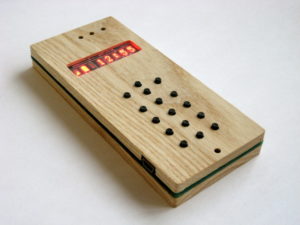
An exploration into the possibilities for individual construction and customization of the most ubiquitous of electronic devices, the cellphone. By creating and sharing open-source designs for the phone’s circuit board and case, we hope to encourage a proliferation of personalized and diverse mobile phones. Freed from the constraints of mass production, we plan to explore diverse materials, shapes, and functions. We hope that the project will help us explore and expand the limits of do-it-yourself (DIY) practice. How close can a homemade project come to the design of a cutting edge device? What are the economics of building a high-tech device in small quantities? Which parts are even available to individual consumers? What’s required for people to customize and build their own devices?
The DIY cellphone combines a custom electronic circuit board with a laser-cut plywood and veneer enclosure. The phone accepts a standard SIM card and works with any GSM provider. Cellular connectivity is provided by the Quectel M10 GSM module, as found on the Arduino GSM shield. The phone’s software is written in Arduino, runs on an ATmega1284P microcontroller, and provides basic functionality like: making and receiving calls, sending and receiving text messages, a phone book, and date and time. The screen is a 84×48 pixel monochrome display (like those found on old Nokia phones). Flexures in the veneer also pressing of the buttons beneath. The phone can be charged with a standard mini-USB cable and re-programmed using an FTDI USB-to-serial cable. The phone includes about $120 in parts.
Project Website
You can find more information about the cellphone, including links to the design files and assembly instructions on the DIY cellphone website.
People
David Mellis
Photos (see more on Flickr)


